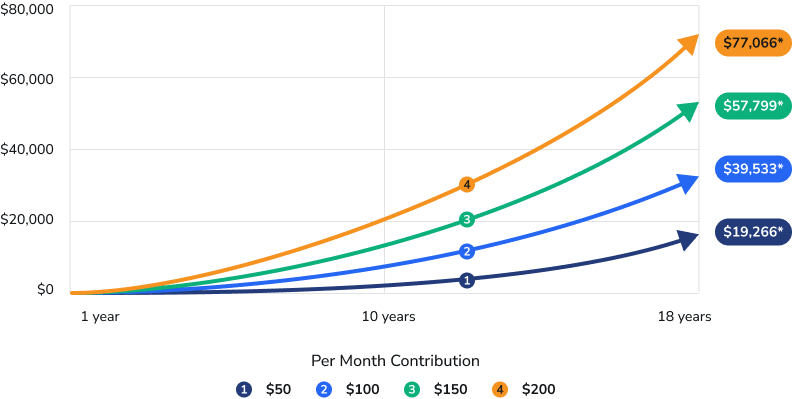The Save4College State Contribution Program is now accepting applications. You may be eligible for a $250 or $500 contribution. Apply by May 31!
Learn MoreJoin Our 529 Day “Intro to College Savings” Webinar
We’re celebrating 529 Day by offering an informational webinar about the Maryland College Investment Plan. Join us on Thursday, May 29 at 12:00 pm.
The basics of 529
What is a 529 plan?
A 529 plan, named after Section 529 of the Internal Revenue Code, is a tax-advantaged education savings plan designed to encourage families to save for future qualified education expenses.
Why a 529 plan
529 plans are tax-advantaged education savings plan designed to encourage families to save for future education expenses.
Explore Investment PlanTax Advantages
Distributions used to pay for qualified education expenses are free from federal and state taxes, helping you keep more of your savings. You may also be eligible for a State income subtraction when you contribute to a 529 plan.
See Tax AdvantagesFlexibility
A 529 plan can be used for more than just saving for accredited colleges. You can also save for apprenticeships, technical or trade schools, and more.
View Qualified ExpensesThis chart shows the potential growth of contributing different amounts monthly over time.

* Chart assumes a hypothetical 6% rate of return compounded monthly and monthly contributions made at the end of each month. This chart is for illustrative purposes and does not represent the return of any specific investment options. Investment returns in a college savings plan will vary and may be higher or lower than this example. This illustration does not include Fees and any Fees assessed by the investment offering could have an impact on returns.
ADVANTAGE OF STARTING TO SAVE EARLIER
Get a Head Start on Their Future, Your Way.
Give your child a head start on their college savings. It's never too late to start saving for your child's college, but the earlier you start, the better. Every contribution can add up. The more you are able to save today, means the less you may have to borrow tomorrow.
How a 529 works
Crafting your 529 strategy
Saving for your child's future education has never been easier.
Open a College Investment Plan Account
With the College Investment Plan managed by T. Rowe Price, an investment management firm with more than 80 years of experience, you can save for your child's future education on your terms—starting with as little as $25.
Open an AccountChoose an Investment Option
Select from flexible portfolio options according to your investment comfort level and target high school graduation year.
Save regularly
Once you open a Maryland College Investment Plan account you can tailor your contributions to your current budget. It's easy to save with one time contributions or recurring contributions with the option of increasing over time.
Get StartedT. Rowe Price Insights
Develop Your Savings Strategy That Will Work Best for You.
Deciding how much to save for your child's education and when to start saving are important first steps in developing a college savings plan.
FAQS
Learn more about 529s
You can use a 529 plan account at nearly any accredited college or university in the country, or internationally, for undergraduate or graduate education. This includes most public and private colleges and universities, graduate and postgraduate schools, community colleges, and certain technical and vocational schools. To find out if a particular school is an eligible educational institution, search for a school code at studentaid.gov. Up to $10,000 per year, per beneficiary can be used toward tuition at K-12 public, private or religious schools.*
The money in your account can also be used for apprenticeship programs registered with the U.S. Department of Labor or for the repayment of qualified education loans.
*While distributions from 529 college savings plans for elementary or secondary education tuition expenses are federally and Maryland State tax-free, state tax treatment in other states will vary and could include state income taxes assessed, the recapture of taxes for previously subtracted amounts from state taxable income, and/or state-level penalties. You should consult with a tax or legal professional for additional information.
Qualified education expenses are defined in the Internal Revenue Code. For a complete list, view IRS Publication 970.
For the distributions to be federally tax-free, you have to use the funds for one of the qualified expenses below:
-
Colleges, Universities, Graduate Schools, and Technical/Vocational Schools:
Tuition and fees; room and board; books, supplies, and equipment required for enrollment or attendance; and computer and technology needs. Certain expenses for special needs students are covered. To be qualified, the institution must be considered an eligible educational institution, which is defined in the Code and further explained in IRS Publication 970.
-
K-12 Tuition for Public, Private, or Religious Schools*:
Tuition expenses of up to $10,000 per year, per beneficiary.
-
Apprenticeship Programs:
Books, fees, equipment, and other supplies.
-
Education Loan Repayment:
The principal or interest on a qualified education loan for the beneficiary. There is a $10,000 lifetime maximum per individual.
*While withdrawals from 529 plans for elementary or secondary education tuition expenses are federally tax-free, state tax treatment will vary and could include state income taxes assessed, the recapture of taxes for previously subtracted amounts from state taxable income, and/or state-level penalties. You should consult with a tax professional for additional information.
529 plans grow tax-deferred, and any earnings are also federally and state tax-free when used toward qualified education expenses. Federal and state taxes and penalties may apply to distributions not used toward qualified education expenses.
You can still use your 529 college savings plan to pay tuition and fees not covered by the scholarship or grant, or you can apply your account toward other qualified educational expenses such as room and board, books, or course-specific fees.
Generally, you can also:
- Transfer your account to another member of your beneficiary's family (by blood or marriage).
- Keep any unused funds in your account to pay for future qualified education expenses, like graduate school.
- Withdraw any unused funds up to the amount of the scholarship or grant without the 10% federal penalty, although income taxes on any earnings may apply.
- Rollover unused funds in a 529 college savings plan account to a Roth IRA maintained for the same account beneficiary. The 529 plan account must have been maintained for at least 15 years and only contributions (and accompanying earnings) made more than five years prior can be rolled over. The amount eligible for rollover each year cannot exceed the IRA contribution limit and there is an aggregate limit of $35,000.
Typically, a 529 plan does not require the child to attend college immediately after graduating high school. In general, if the child decides not to go to college, you may transfer the account to any relative of the child or request a refund or non-qualified distribution from your account.
Another option beginning in 2024, SECURE 2.0 allows for a rollover of unused amounts in a 529 college savings plan account to a Roth IRA maintained for the same account beneficiary. The 529 plan account must have been maintained for at least 15 years and only contributions (and accompanying earnings) made more than five years prior can be rolled over. The amount eligible for rollover each year cannot exceed the IRA contribution limit and there is an aggregate limit of $35,000.
If you are the account owner and your child is the beneficiary of the 529 account and a dependent student, the money you have saved is typically considered a parental asset, not a student asset.
In that case, the family can expect the student's need-based aid package to be reduced by up to 5.64% of the asset's value. This means that if parents have saved $5,000 for college, the aid amount your student may be eligible for would be reduced by $280. Certain exclusions may also apply which could impact this amount.
If the asset is considered a student's asset, a family can expect the student's need-based aid package to be reduced by up to 20%.
Note: Starting in the 2024-2025 school year, distributions from a grandparent-owned 529 account will no longer count as income to the student on the Free Application for Federal Student Aid (FAFSA).This change means that, in most cases, funding a grandchild's education through a 529 account will no longer have any bearing on their eligibility for financial aid that is based on the FAFSA.
For more information visit studentaid.gov/h/apply-for-aid/fafsa.
The Save4College State Contribution Program is Now Accepting Applications for 2025!
Open a Maryland College Investment Plan Account and apply by May 31.


